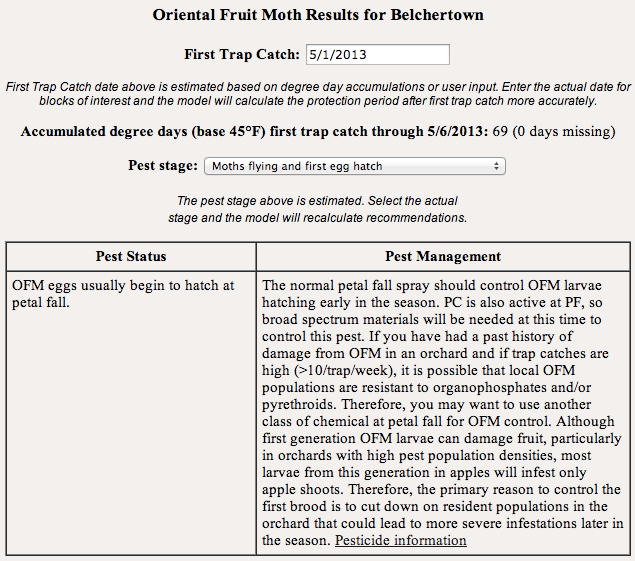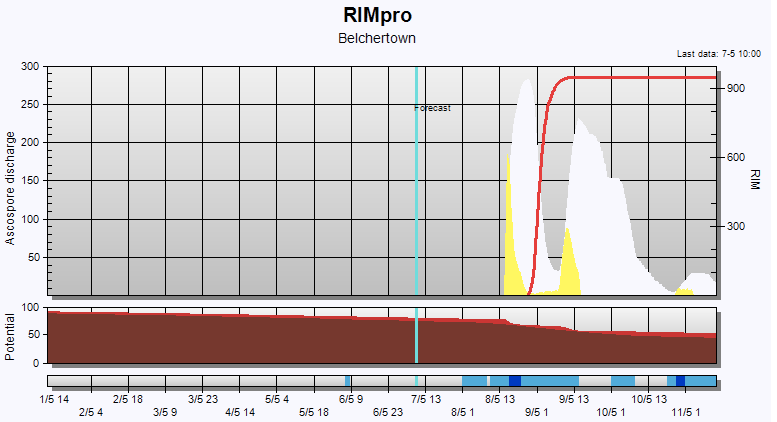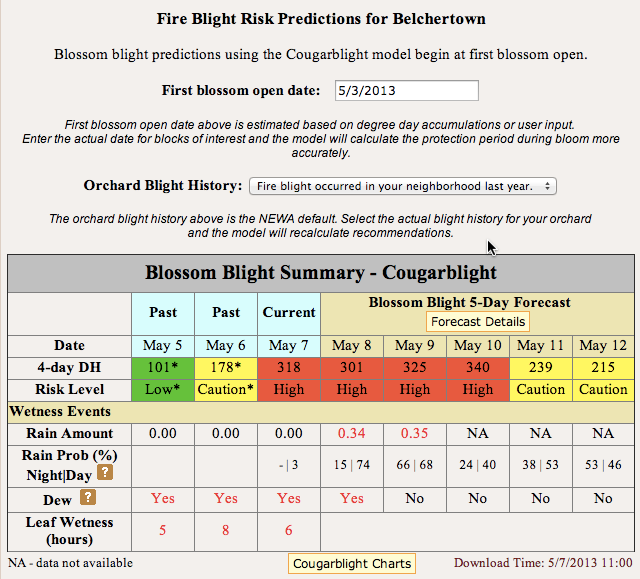

Current degree day accumulations
Location: UMass Cold Spring Orchard, Belchertown, MA
6-May, 2013 |
|
| Base 43 | 285 |
| Base 50 | 164 |
Location: UMass Cold Spring Orchard, 6-May, 2013
| Honeycrisp apple | first king bloom |
| McIntosh apple | king bloom |
| Rainier cherry | bloom+ |
| PF-14 Jersey peach | bloom+ |
| Gold Bosc pear | bloom |
See pictures of current bud stages here: http://extension.umass.edu/fruitadvisor/may-6-2013-bud-stages
| Coming events | Degree days (Base 43) |
| Green fruitworm flight subsides | 251-451 |
| Redbanded leafroller 1st flight peak | 234-368 |
| Spotted tentiform leafminer 1st oviposition | 143-273 |
| Spotted tentiform leafminer 1st flight peak | 268-404 |
| Green apple aphid present | 111-265 |
| Lesser apple worm 1st catch | 363-561 |
| Obliquebanded leafroller larvae active | 158-314 |
| European red mite egg hatch | 231-337 |
| Oriental fruit moth 1st flight peak | 347-547 |
| Pear psylla 1st egg hatch | 174-328 |
| McIntosh bloom | 349-419 |
May 8 (Wednesday): University of New Hampshire/UMass Tree Fruit Growers' Meeting, Brookdale Fruit Farms,41 broad Street, Hollis, NH. 5:15-7:30 PM. 2 pesticide recertification credits available. See meeting flyer here.
May 14 (Tuesday): UMass Fruit Team Twilight Meeting, UMass Cold Spring Orchard, 391 Sabin St., Belchertown, MA. 5:30 PM. 1 pesticide re-certification credit will be available. $20/25 meeting charge.
May 16 (Thursday): University of Rhode Island/UMass Fruit Twilight Meeting,Old Stone Orchard, 33 Cold Brook Rd., Little Compton, RI. 5:30 PM. 1 pesticide re-certification credit will be available. $20/25 meeting charge.
We are exiting a period of unprecedented (for this time of year) dry, fair weather. Western Mass. has been noticeably warmer than eastern Mass. Stone fruit bloom in Belchertown has been just spectacular with wonderful pollinating weather. It has been observed, however, that bee and other native pollinator activity seems to be weaker than most years? McIntosh apples are at king bloom as of today (Tuesday) and Zestar! has been in full bloom for a day or two. Of course now that apples are going to be in bloom, it's going to start raining, but at least frost does not appear to be an issue for the foreseeable future.
With upcoming rain, disease pressure will be extremely high on all fronts (except one maybe): apple scab, rust, and mildew (less so on mildew, but we are in a period of high risk for mildew infection; pear fabraea leaf spot; and stone fruit brown rot and bacterial spot. The one maybe is fire blight -- so much depends on the forecast and when bloom is open for your location. Using NEWA (http://nea.cornell.edu) and running the Cougar Blight model for your locations is a must when determining fire blight risk. Needless to say if the the risk is indicated as High or Extreme for your orchard a streptomycin spray at bloom needs to be applied. Using the NEWA model and appropriately timed streptomycin spray(s), well, there is really no excuse for getting fire blight. For all disease control sprays, consult the 2013 New England Tree Fruit Management Guide for specific chemicals and rates and application directions.
Make note of the fact that our first May twilight meeting is tomorrow night (May 8, Wednesday) at Brookdale Fruit Farm in New Hampshire. On May 14 we will meet at the UMass Orchard in Belchertown and on May 16 we are headed to the Rhode Island shore (Little Compton). So mark your calendar for next week's meetings. JC
Pheromone traps for Oriental Fruit Moth (OFM) should be placed to determine the first catch of overwintering moths. First adult moth catch was app. May 1 at the UMass Orchard in Belchertown. Traps have caught upwards of 100 moths (cumulative catch).

It's time to deploy pheromone traps for codling moth and oblique-banded leafroller to set Biofix for later treatment.
As mentioned, still no apple scab infection periods since green tip. The next rain event, however, is likely to be a major scab infection period. We have been fortunate to run the RIMpro model for Belchertown this year and below is the current (7-May) output:

The important points to consider on above are:
You get the picture, the upcoming rain event presents significant scab infection risk with upwards of 2/3 potential spore release. Be covered with protectant fungicide, and if the infection event is prolonged, be prepared to spray again in a few days with some kickback/systemic fungicide.
Regarding fire blight, here is the current Cougarblight model output from NEWA:

High indicates the need to apply streptomycin (Firewall 17 WP @ 8 oz. per 100 gallons dilute application or 24 oz. per acre, include Regulaid @ 1 pt. per 100 gallons finished spray) to open apple (and pear) bloom within 24-48 hours of a rain event. (24 hours is preferable.) It's best to cover as much open bloom as you can when spraying streptomycin, so wait until as close to the rain event as you can to spray. As bloom continues to open, re-application will be necessary if the forecast continues to call for High fire blight infection risk.
Be sure to de-blossom newly planted trees to prevent fire blight infection. For specific recommendations see Fire Blight Control on Newly Planted Apple Trees: http://jerseyfruitagupdates.blogspot.com/2013/05/fire-blight-control-on-newly-planted.html
Crop Load Management at Petal Fall -- Duane Greene
We are about to enter the fruit development stage where chemical thinning is done. Most orchards are in full bloom or will soon be there. Petal fall will occur soon after, and petal fall is generally the stage of development that most orchardists start their thinning program. I consider this to be an extremely important opportunity to adjust crop load down. There are only four legitimate reasons to skip a petal fall thinning spray:
Considering the current weather forecast for the week, careful monitoring of bee and other pollinator activity appears to be important to help you judge how effective pollination really was.
There are generally three options that orchardist have for thinning at petal fall.
Carbaryl -- this is the most conservative choice and it is the choice selected by the majority of growers. Carbaryl is a mild thinner that rarely overthins. The thinning activity is not concentration dependent, thus errors in the amount applied rarely affect the extent of thinning. Rates between 1 pint to 1 quart/100 gallons are frequently selected rates.
Naphthaleneacetic acid (NAA) -- this is a more aggressive approach to thinning that should be considered on varieties and in blocks that have a history of oversetting. The thinning potential of NAA when applied at bloom is lower than when the same rate is applied at the 7 to 14 mm stage. You will have a choice between two (possibly 3) NAA formulations.
Carbaryl plus NAA -- this combination is generally considered the most aggressive approach to thinning at petal fall. It is useful for thinning of hard to thin varieties. When used at petal fall it has a lower thinning potential than when used at the more traditional thinning time of the 7 to 14 mm stage.
Much has been written and said about using the carbon balance model (see http://newa.cornell.edu/index.php?page=apple-thin) as an aid in determining when to thin and what products to put in the spray tank to thin. It is based on the observation that there is a strong demand for carbohydrate as fruit increase in size. It is an extremely useful tool in making thinning decisions at the 7 to 14 mm fruit size stage when fruit growth is rapid, however, fruit growth is relatively slow at petal fall and shortly after, thus carbohydrate demand is relatively low. Making thinning decisions at petal fall based upon a projected carbohydrate deficit should be tempered by the fact that carbohydrate demand to sustain growth is low to moderate until fruit reach about the 5 to 6 mm size range.
The petal fall spray is extremely important. Do not wait for ideal weather except where rain or windy conditions prevail. As soon as the bees are removed from the orchard, apply a petal fall spray. You will always have another chance.
Use of Apogee at Petal Fall
The use of Apogee for growth retardation and retardation of shoot fire blight. The suggested time for the initial application for both purposes is petal fall (when shoots are 1 to 2 inches in length). There is some flexibility related to the time of initial application but generally the earlier the better, since shoot growth is generally quite rapid early. However, application when many petals are still on the tree may be counterproductive since the presence of petals may interfere with the spray thus preventing good spray coverage.
Initial application of Apogee is recommended to be between 2 to 4 oz/100 gal. While these rates may seem low, a near identical reduction in terminal growth is achieved with these rates as compared with higher rates. If a lower rate is selected then reapplication will probably be needed earlier. We suggest the lower rates because rates of 6 oz per 100 gal may interfere with the thinning response to chemical thinners by reducing June drop. Following application Apogees requires 10 to 14 days for growth retardation to take effect.
Promalin or Perlan
I am uncertain how many use Promalin to elongate fruit. Obvious candidates for use include Delicious and Cameo but in other areas it is also used on Gala. The king flower stage of flower development is probably the best time for this application. You may use either 1 or 2 pints per acre. Generally there is a greater response when the higher rate is used. The addition of a surfactant usually improves the response. If you choose to apply the 2 pint per acre rate with a surfactant you may also get some thinning along with improved fruit shape.
Guest article: DISRUPTIVE BEHAVIOR
(Greg Krawczyk and Larry Hull, Penn State Univ., Biglerville; Art Agnello, Entomology, Geneva)
Reprinted from Scaffolds Fruit Journal, MAY 6, 2013, Volume 22, No. 7.
[We are reprinting some excerpted advice on mating disruption of internal-feeding Lepidoptera contributed a couple of years ago by our Pennsylvania colleagues, with a few updates, to help in your preparations for managing these pests, which are already beginning to show up.]
For growers planning to use mating disruption as part of their annual codling moth (CM) management program, you should have already purchased your products for this year. There are a number of products on the market that affect both codling moth and the oriental fruit moth (OFM) simultaneously, in addition to a number of products that just affect just a single species. Briefly, if your target is both CM and OFM, there are a number of products that affect both pests – CheckMate CM/OFM Duel, CheckMate CM/OFM Puffer, and Isomate CM/OFM TT. Please follow the label for each product for dispenser density and placement within the tree (i.e., for CM, place the dispensers in the top 20 percent of the tree canopy). Even though OFM has already started to fly, the above products should be in place before CM biofix.
For those growers who have used a mating disruption product for CM in previous years, it is likely that you will need some supplemental insecticides, especially for the first generation (see below for a listing of product choices). In addition, it is very important that you place pheromone traps in trees to monitor the success of your mating disruption program. We have conducted a number of studies with a newer lure from Trécé Inc. to monitor CM in mating disruption blocks, called a CM-DA Combo. It contains both the sex pheromone – that is released by the females to attract the males – and a kairomone (i.e., a plant-derived chemical volatile [i.e., pear ester]) that attracts both male and female moths. We recommend at least one trap per 5 acres with no less than one trap per 10 acres to determine the success of your mating disruption program. There are also powerful 10X lures available for monitoring CM male adults in mating disruption blocks. These products are available from either Suterra LLC, Trécé Inc, or other distributors.
If your plan is to use just conventional insecticides for CM control this year, your choice of products is quite varied, depending on the stage of CM you wish to target. Products that possess ovicidal activity (i.e., affecting the eggs) should be applied as follows: Intrepid (16 fl oz/acre) – apply within 150–175 DD after biofix and repeat 14 days later. Insecticides that target the hatching larvae (i.e., 230–250 DD after biofix) are as follows: diamides (e.g., Altacor, Belt), organophosphates, various neonicotinoids (e.g., Assail, Calypso), Avaunt, and Delegate. Please refer to the Tree Fruit Guidelines for rates on these products. It is important to implement good resistance management practices for all of the above products (i.e., use only one of the above active ingredients within the same generation of CM; do not use the same active ingredients across two consecutive generations).
Another option that growers can consider for CM control is a codling moth granulosis virus (CpGV) (i.e., Carpovirusine, Cyd-X, Virosoft). We have used these products very successfully over the past few years in combination with mating disruption to reduce the severity of this pest. CpGV products must be ingested by the hatching larvae. The larvae will continue to feed for a couple of days before the virus kills them. CpGV products are fairly short residual (i.e., 5–7 days); thus, they need to be reapplied more often than conventional insecticides. Growers will likely need 4–5 applications per generation depending the length of the egg hatch period, the severity of the populations, and weather conditions. [Note: Madex HP, the new Certis product containing a CpGV that is active on both CM and OFM, is not yet labeled in NYS.]
Even if you are just using insecticides or CpGV for CM control this year, don't forget to use pheromone traps to monitor adult populations in your orchards. Monitoring traps in insecticide-only treated orchards require the use of a 1X lure. The traps are very important for setting biofix, determining the seasonality of adult flight, and they can estimate the relative adult population density in the immediate area. We don't yet have any reliable moth capture thresholds for determining whether to spray or not spray in insecticide-only treated orchards. [Note: However, we have recognized the utility in relying on the provisional "ballpark" values of 5 CM/trap and 10 OFM/trap - AMA.]
UMass Fruit Advisor: http://umassfruit.com
Scaffolds Fruit Journal: http://www.nysaes.cornell.edu/ent/scafolds/
Network for Environment and Weather Applications (NEWA): http://newa.cornell.edu
Follow me on Twitter (http://twitter.com/jmcextman) and Facebook (http://www.facebook.com/jmcextman)
UMass Vegetable & Fruit IPM Network (on Facebook, http://www.facebook.com/umassipmteam)
The next Healthy Fruit will be published on Tuesday, May 14 or thereabouts, 2013. As always feel free to get in touch with any member of the UMass Fruit Team (http://extension.umass.edu/fruitadvisor/team-members) if you have questions or comments.